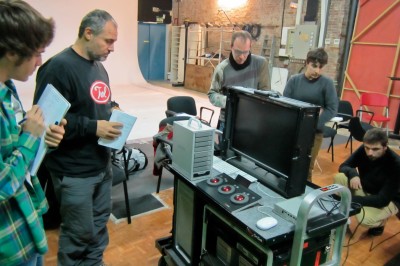Courses
DIT Course Evaluation: Module IV
To finish with the DIT course, organized by 709 Media Room in collaboration with Rafa Roche, on December 20 and 21 were two specific days on the work of DIT.
Most of the module was taught by Daniel Perez-Llebot, supervisor of postproduction, visual effects and digital services on set, with extensive experience in multiple companies and countries, and one of the creators of WhyOnSet.
During the first part of the 20th, Rafa Roche and Luis Ochoa gave a joint class in which they explained in detail the functions of a DIT (Digital Imaging Technician), as well as the differences with a Data Wrangler, Data Management or Media Management.

In this way, we talked again about card dumps, their working structure to know how to name them consistently, and methods of marking them so that the whole camera team is able to recognize at a glance which ones have not been dumped yet and which ones can be worked with.
Another topic that came up during this day was corrupted clips, so Rafa and Luis gave us some tips on what to do if we encounter one, what data recovery programs we can use, etc.
And if we are talking about card dumps, of course, we have to talk about hard disks. With them we touched different aspects, such as the types of formatting (FAT 32, EXFAT, NTFS or HFS+) and their corresponding problems that we can find, for example, due to some camera cards. Luis and Rafa named some software that could solve these problems and gave us tips on how to manage hard disks with several partitions. They also explained the RAID hard disk structures and their different types.
Then it was Daniel Pérez’s turn, who began by showing us how the WhyOnSet digital mobile lab was set up.
He brought with him different workstations, a smaller one that used a laptop and an expansion box, and another one that consisted of the complete cart. Daniel talked to us about the strengths and weaknesses of each of them to be taken into account depending on the type of production we are working on.
The cart has a number of elements that are fully customizable, as you can choose to mount them or not and add peripherals as you need them. In addition, some of them, such as the tower or the monitor, are protected with metal plates so that no impact can be harmful.
In this case, the cart was equipped with: Mac Pro (tower), ATI and RED Rocket cards, keyboard, mouse, Tangent Element controller (the central module), HP DreamColor monitor, LTO tape recorder, multi-card reader, 24TB hard drive with SAS connection (consisting of 8 hard drives with RAID 5), Onboard Códex recorder and HyperDeck Studio recorder.
After showing us how all these elements were assembled one by one, we talked about the configuration of a monitor, the adjustments we should make so that in postproduction they can see the reference material as close as possible to the work that the DIT did in shooting.
One of the most widely used systems for creating dailies with integrated color correction is Scratch. Therefore, Daniel showed us its interface and recreated the process from file import through color grading to output. In this simulation Daniel also took the opportunity to show us how Shot Put Pro, a software for data copying and verification, works.
Finally, we did a little practice using the digital lab, coupled with a Sony F3 and the HyperDeck Studio recorder.
This is how we ended the last day of the DIT course; a very intensive course that covers the processes between shooting and post-production and makes it one of the most complete courses about DIT work and color correction.
If you are interested in future calls for this course, here you have all the information and detailed syllabus. You can also read the evaluations of the previous modules from this link.




